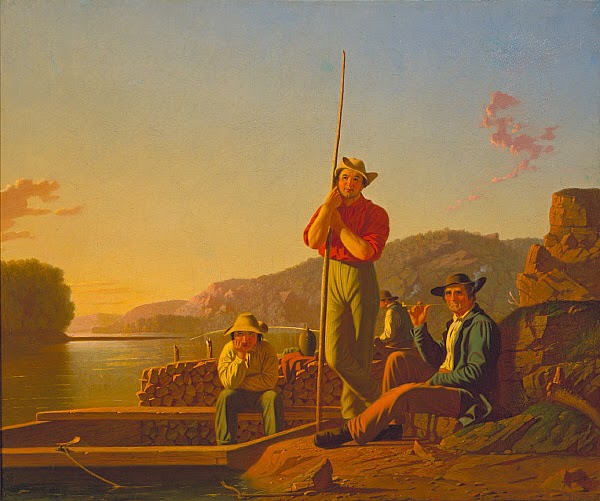This weekend I had the opportunity visit the Amon Carter Museum of American Art in Ft. Worth, Texas. If you are ever in the vicinity make room for a stroll through Ft. Worth’s Cultural District over to Camp Bowie Street and visit. Carter’s bequest that set up the museum after his death has made it possible for the museum to maintain FREE admission to this world class installment of American Art.
The museum itself is really easy to get to from the freeway. I-35to I-30 and then Montgomery Exit, turn right, a couple miles through the “Cultural District” past the fields where they have the horse shows, the American Quarter Horse News building, the Museum of Natural History, and a right on Camp Bowie and the Museum is on the right. They have a modest-sized parking lot but get there early and you have no problem finding a spot.
They also generously allow photography of their collections which is quite helpful in teaching art of the American West. Amon Carter was one of those “self-made men” that you often hear about. His philanthropy with this museum will always be a lasting tribute to his life.
The staff, docents, and volunteers are all quite friendly and have an intimate knowledge of their collections, especially their Frederic Remington and Charles Russell collections of which I will write about more in a later post.
Two floors consisting of 20 galleries sounds cramped, but it is surprisingly open and allows for pretty free movement in and out of the exhibits. Being part of the Texas Museum tradition the museum is built with fossiliferous limestone.
 |
| General Layout for the galleries, surprisingly spacious for a smaller museum. |
This, the Bierstadt, the Catlins, the Cole, all the Remington and Russell pieces, and the one Alfred Jacob Miller and Bingham in the permanent collections are reasons to visit. The Navigating the West George Caleb Bingham special exhibit is reason to go before January 18, 2015.
An interesting correlation is the modern photography exhibit on the (northern, more urban part of the) Trinity River near Bingham’s early river scenes. Growing up in Southeast Texas I can, without exaggeration of hyperbole, safely say that there are people that live on the southern run of the Trinity that look exactly like some of the folks that Bingham painted over 150 years ago.

This is the only time I know of that all the river paintings have all been in one place. They are on loan from places you may have heard of like the National Gallery and the MET. Two of his nocturns (night paintings) are included as well as his large Dusseldorf painting. Bingham’s sketches are included near their finished pieces which is a treat to see not only the technological process but the artist’s process as well. To take that even further they have infrared scanned all the images to be certain what sketch went with what painting (and with Bingham that was usually more than one). They have included digital overlays of those scans which have revealed not only subtle changes in composition, but things like trees and ship’s masts being removed from the finished images we now see.
There are examples of the prints that were made by the American Art Union as well as other printmakers later. Go and see this. It leaves Ft. Worth and goes to the St. Louis Art Museum (SLAM–no, really SLAM) and then ends at the Metropolitan Museum of Fine Art. Seeing it before all the artsy folks in New York should be enough reason to go.
The exhibit also includes the LAST panoramic display painting of a Mississippi trek. On loan from St. Louis this enormous (nearly 350 feet long) piece that was part of a traveling lecture entertainment series is one of the best things about the exhibit. I am piecing together a full post on it because it was commissioned by an amateur archaeologist and is filled with wonderful images of Indian burial mounds and excavations along the Mississippi River. Displayed with music and lecture and sometimes smoke for the steamship, think of this as the zenith of mid nineteenth century 4D experiences.
I hope you get a chance to go through the exhibit. I was lucky enough to go through it with the curator, Dr. Nenette Luarca-Shoaf, which made it even more powerful. Her work with Bingham, rivers, and science and art is certainly a new direction that I hope my own discipline is going. Follow her on
Twitter and listen to an interview/podcast
here.If you live in Ft. Worth and have never visited the Amon Carter Museum, you should be ashamed. There, right down the street is not only a fantastic museum, but a lasting tribute to someone who used their wealth for education and betterment of a community that he loved dearly. So it is the least you can do to thank Mr. Carter for his forward thinking and generosity.
Whether you are into art or not, you may recognize the name. The Amon Carter Museum is only three and a half miles from the Amon G. Carter Stadium at TCU. Hundreds of people from the University I attend was in Ft. Worth Saturday as well visiting Carter Stadium instead of Carter Museum. OU lost to TCU 37-33.
 |
| Posthumous portrait of Amon Carter. |
My most heartfelt thanks to Mr. Carter and his family for offering this to Ft. Worth in particular, but to the American people in general. It was a pleasure and delight to visit, and I hope to get back there again.
Update 10/20/14: Amon Carter added a video overview to youtube provided by the other curator of the exhibit: Watch it here:




























